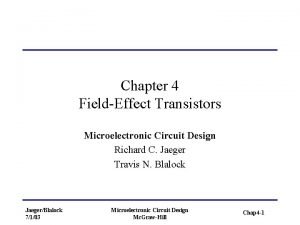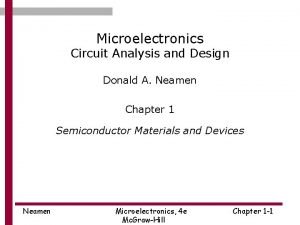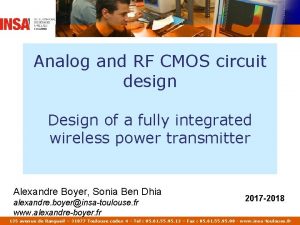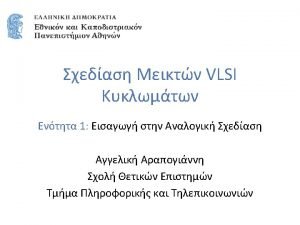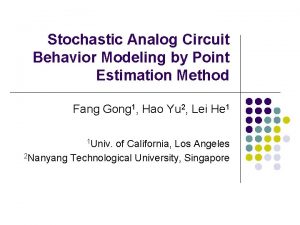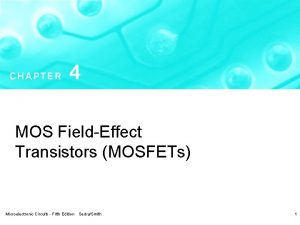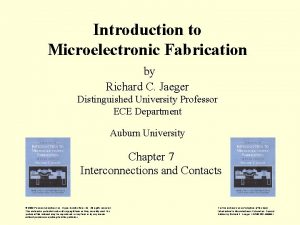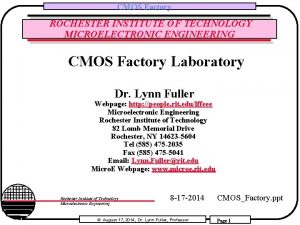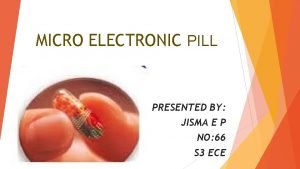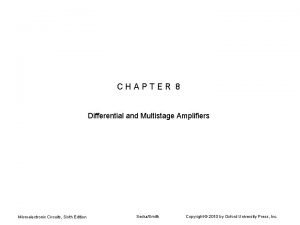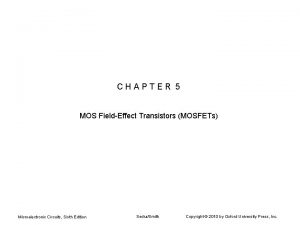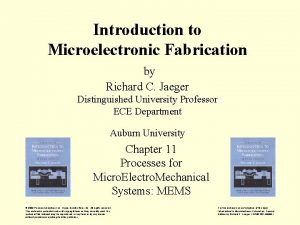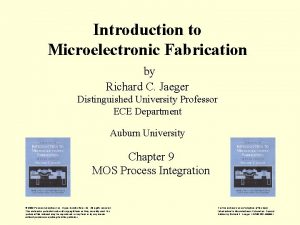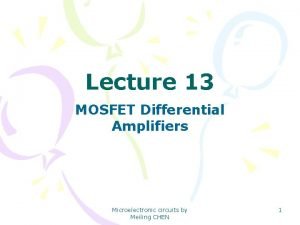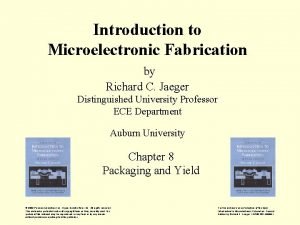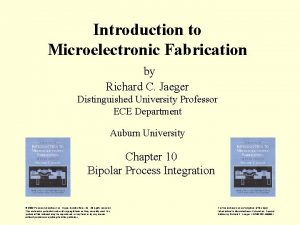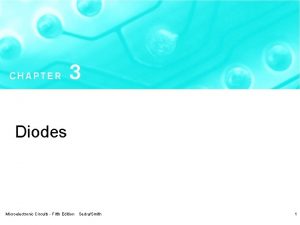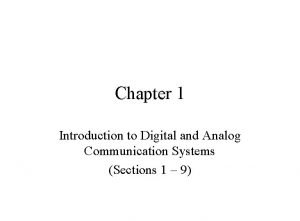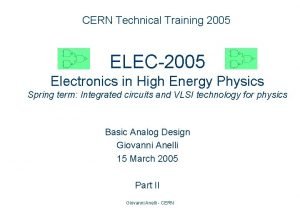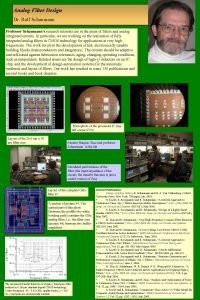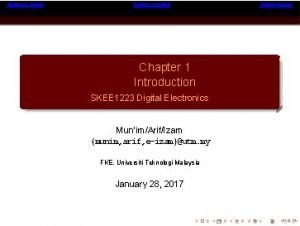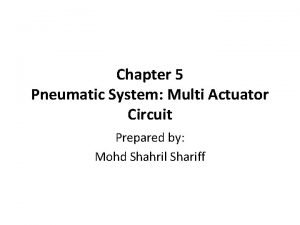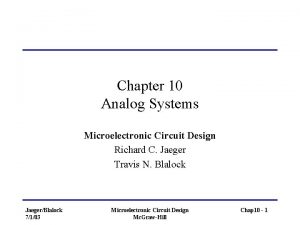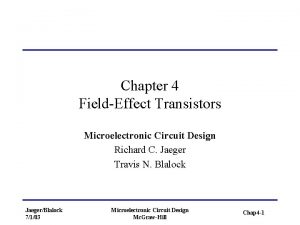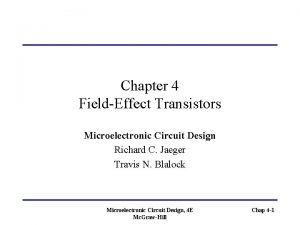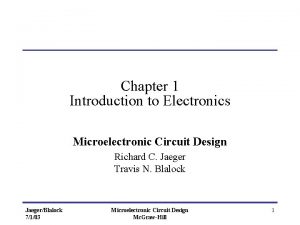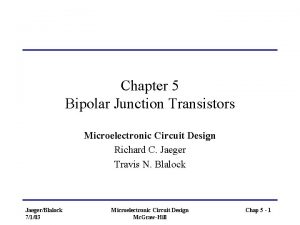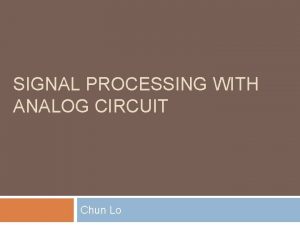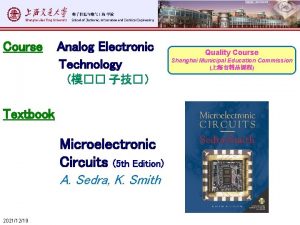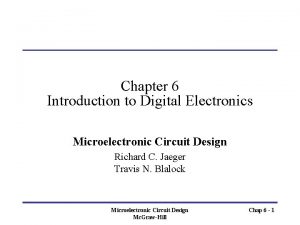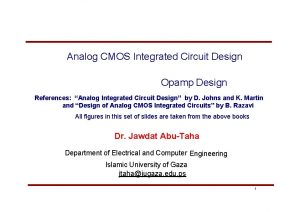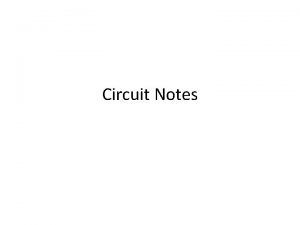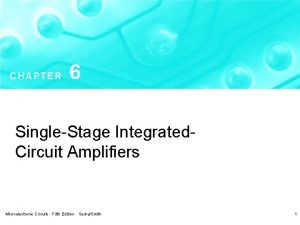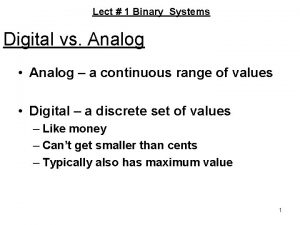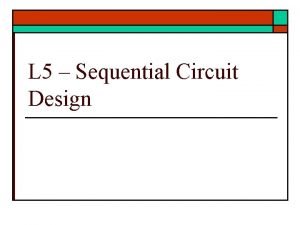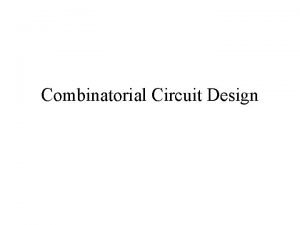Chapter 10 Analog Systems Microelectronic Circuit Design Richard







































- Slides: 39

Chapter 10 Analog Systems Microelectronic Circuit Design Richard C. Jaeger Travis N. Blalock Jaeger/Blalock 7/1/03 Microelectronic Circuit Design Mc. Graw-Hill Chap 10 - 1

Chapter Goals • Develop understanding of linear amplification concepts such as: – – – Voltage gain, current gain, and power gain, Gain conversion to decibel representation, Input and output resistances, Transfer functions and Bode plots, Cutoff frequencies and bandwidth, Low-pass, high-pass, band-pass, and band-reject amplifiers, Biasing for linear amplification, Distortion in amplifiers, Two-port representations of amplifiers, g-, h-, y-, and z-parameters, Use of transfer function analysis in SPICE. Jaeger/Blalock 7/1/03 Microelectronic Circuit Design Mc. Graw-Hill Chap 10 - 2

Example of Analog Electronic System: FM Stereo Receiver • Linear functions: Radio and audio frequency amplification, frequency selection (tuning), impedance matching(75 -W input, tailoring audio frequency response, local oscillator • Nonlinear functions: DC power supply(rectification), frequency conversion (mixing), detection/demodulation Jaeger/Blalock 7/1/03 Microelectronic Circuit Design Mc. Graw-Hill Chap 10 - 3

Amplification: Introduction A complex periodic signal can be represented as the sum of many individual sine waves. We consider only one component with amplitude VS =1 m. V and frequency w. S with 0 phase (signal is used as reference): Amplifier output is sinusoidal with same frequency but different amplitude VO and phase θ: Jaeger/Blalock 7/1/03 Microelectronic Circuit Design Mc. Graw-Hill Chap 10 - 4

Amplification: Introduction (contd. ) Amplifier output power is: Here, PO = 100 W and RL=8 W Output power also requires output current which is: Input current is given by phase is zero because circuit is purely resistive. Jaeger/Blalock 7/1/03 Microelectronic Circuit Design Mc. Graw-Hill Chap 10 - 5

Amplification: Gain • Voltage Gain: Magnitude and phase of voltage gain are given by and For our example, • Current Gain: Magnitude of current gain is given by Jaeger/Blalock 7/1/03 Microelectronic Circuit Design Mc. Graw-Hill Chap 10 - 6

Amplification: Gain (contd. ) • Power Gain: For our example, On decibel scale, i. e. in d. B Jaeger/Blalock 7/1/03 Microelectronic Circuit Design Mc. Graw-Hill Chap 10 - 7

Amplifier Biasing for Linear Operation VI = dc value of v. I, vi = time-varying component For linear amplification- v. I must be biased in desired region of output characteristic by VI. If slope of output characteristic is positive, input and output are in phase (amplifier is non-inverting). If slope of output characteristic is negative, input and output signals are 1800 out of phase (amplifier is inverting). Jaeger/Blalock 7/1/03 Microelectronic Circuit Design Mc. Graw-Hill Chap 10 - 8

Amplifier Biasing for Linear Operation (contd. ) Voltage gain depends on bias point. Eg: if amplifier is biased at VI = 0. 5 V, voltage gain will be +40 for input signals satisfying If input exceeds this value, output is distorted due to change in amplifier slope. Jaeger/Blalock 7/1/03 Microelectronic Circuit Design Mc. Graw-Hill Chap 10 - 9

Amplifier Biasing for Linear Operation (contd. ) Output signals for 1 k. HZ sinusoidal input signal of amplitude 50 m. V biased at VI= 0. 3 V and 0. 5 V: For VI =0. 3 V: Gain is 20, output varies about dc level of 4 V. For VI =0. 5 V: Gain is 40, output varies about dc level of 10 V. Jaeger/Blalock 7/1/03 Microelectronic Circuit Design Mc. Graw-Hill Chap 10 - 10

Distortion in Amplifiers • Different gains for positive and negative values of input cause distortion in output. • Total Harmonic Distortion (THD) is a measure of signal distortion that compares undesired harmonic content of a signal to the desired component. Jaeger/Blalock 7/1/03 Microelectronic Circuit Design Mc. Graw-Hill Chap 10 - 11

Total Harmonic Distortion dc desired output 2 nd harmonic distortion 3 rd harmonic distortion Numerator= sum of rms amplitudes of distortion terms, Denominator= desired component Jaeger/Blalock 7/1/03 Microelectronic Circuit Design Mc. Graw-Hill Chap 10 - 12

Two-port Models for Amplifiers • Simplifies amplifier-behavior modeling in complex systems. • Two-port models are linear network models, valid only under small-signal conditions. • Represented by g-, h-, y- and z-parameters. • (v 1, i 1) and (v 2, i 2) represent signal components of voltages and currents at the network ports. Jaeger/Blalock 7/1/03 Microelectronic Circuit Design Mc. Graw-Hill Chap 10 - 13

g-parameters Using open-circuit (i=0) and shortcircuit (v=0) termination conditions, Open-circuit input conductance Reverse short-circuit current gain Forward open-circuit voltage gain Short-circuit output resistance Jaeger/Blalock 7/1/03 Microelectronic Circuit Design Mc. Graw-Hill Chap 10 - 14

g-parameters: Example Problem: Find g-parameters. Approach: Apply specified boundary conditions for each g-parameter, use circuit analysis. For g 11 and g 21: apply voltage v 1 to input port and open circuit output port. For g 12 and g 22: apply current i 2 to output port and short circuit input port. Jaeger/Blalock 7/1/03 Microelectronic Circuit Design Mc. Graw-Hill Chap 10 - 15

Hybrid or h-parameters Using open-circuit (i=0) and shortcircuit (v=0) termination conditions, Short-circuit input resistance Reverse open-circuit voltage gain Forward short-circuit current gain Open-circuit output conductance Jaeger/Blalock 7/1/03 Microelectronic Circuit Design Mc. Graw-Hill Chap 10 - 16

h-parameters: Example Problem: Find h-parameters for the same network (used in g-parameters example). Approach: Apply specified boundary conditions for each h-parameter, use circuit analysis. For h 11 and h 21: apply current i 1 to input port and short circuit output port. For h 12 and h 22: apply voltage v 2 to output port and open circuit input port. Jaeger/Blalock 7/1/03 Microelectronic Circuit Design Mc. Graw-Hill Chap 10 - 17

Admittance or y-parameters Using open-circuit (i=0) and shortcircuit (v=0) termination conditions, Short-circuit input conductance Reverse short-circuit transconductance Forward short-circuit transconductance Short-circuit output conductance Jaeger/Blalock 7/1/03 Microelectronic Circuit Design Mc. Graw-Hill Chap 10 - 18

y-parameters: Example Problem: Find y-parameters for the same network (used in g-parameters example). Approach: Apply specified boundary conditions for each y-parameter, use circuit analysis. For y 11 and y 21: apply voltage v 1 to input port and short circuit output port. For y 12 and y 22: apply voltage v 2 to output port and short circuit input port. Jaeger/Blalock 7/1/03 Microelectronic Circuit Design Mc. Graw-Hill Chap 10 - 19

Impedance or z-parameters Using open-circuit (i=0) and shortcircuit (v=0) termination conditions, Open-circuit input resistance Reverse open-circuit transresistance Forward open-circuit transresistance Open-circuit output resistance Jaeger/Blalock 7/1/03 Microelectronic Circuit Design Mc. Graw-Hill Chap 10 - 20

z-parameters: Example Problem: Find z-parameters for the same network (used in g-parameters example). Approach: Apply specified boundary conditions for each zparameter, use circuit analysis. For z 11 and z 21: apply current i 1 to input port and open circuit output port. For z 12 and z 22: apply current i 2 to output port and open circuit input port. Jaeger/Blalock 7/1/03 Microelectronic Circuit Design Mc. Graw-Hill Chap 10 - 21

Mismatched Source and Load Resistances: Voltage Amplifier g-parameter representation (g 12=0) with Thevenin equivalent of input source: If Rin >> Rs and Rout<< RL, In an ideal voltage amplifier, and Rout =0 Jaeger/Blalock 7/1/03 Microelectronic Circuit Design Mc. Graw-Hill Chap 10 - 22

Mismatched Source and Load Resistances: Current Amplifier h-parameter representation (h 12=0) with Norton equivalent of input source: If Rs >> Rin and Rout>> RL, In an ideal current amplifier, and Rin=0 Jaeger/Blalock 7/1/03 Microelectronic Circuit Design Mc. Graw-Hill Chap 10 - 23

Amplifier Transfer Functions Av(s)=Frequency-dependent voltage gain Vo(s) and Vs(s) = Laplace Transforms of input and output voltages of amplifier, (In factorized form) (-z 1, -z 2, …-zm)=zeros (frequencies for which transfer function is zero) (-p 1, -p 2, …-pm)=poles (frequencies for which transfer function is infinite) (In polar form) Bode plots display magnitude of the transfer function in d. B and the phase in degrees (or radians) on a logarithmic frequency scale. . Jaeger/Blalock 7/1/03 Microelectronic Circuit Design Mc. Graw-Hill Chap 10 - 24

Low-pass Amplifier: Description • Amplifies signals over a range of frequencies including dc. • Most operational amplifiers are designed as low pass amplifiers. • Simplest (single-pole) low-pass amplifier is described by Ao = low-frequency gain or mid-band gain w. H = upper cutoff frequency or upper half-power point of amplifier. Jaeger/Blalock 7/1/03 Microelectronic Circuit Design Mc. Graw-Hill Chap 10 - 25

Low-pass Amplifier: Magnitude Response For w<<w. H : For w>>w. H : For w=w. H : • Gain is unity (0 d. B) at w=Aow. H , called gain-bandwidth product • Bandwidth (frequency range with constant amplification )= w. H (rad/s) Jaeger/Blalock 7/1/03 Microelectronic Circuit Design Mc. Graw-Hill Chap 10 - 26

Low-pass Amplifier: Phase Response If Ao positive: phase angle = 00 If Ao negative: phase angle = 1800 At w. C: phase =450 One decade below w. C: phase =5. 70 One decade above w. C: phase =84. 30 Two decades below w. C: phase =00 Two decades above w. C: phase =900 Jaeger/Blalock 7/1/03 Microelectronic Circuit Design Mc. Graw-Hill Chap 10 - 27

RC Low-pass Filter Problem: Find voltage transfer function Approach: Impedance of the capacitor is 1/s. C, use voltage division Jaeger/Blalock 7/1/03 where Microelectronic Circuit Design Mc. Graw-Hill Chap 10 - 28

High-pass Amplifier: Description • True high-pass characteristic impossible to obtain as it requires infinite bandwidth. • Combines a single pole with a zero at origin. • Simplest high-pass amplifier is described by w. H = lower cutoff frequency or lower half-power point of amplifier. Jaeger/Blalock 7/1/03 Microelectronic Circuit Design Mc. Graw-Hill Chap 10 - 29

High-pass Amplifier: Magnitude and Phase Response For w>>w. L : For w<<w. L : For w=w. L : • Bandwidth (frequency range with constant amplification ) is infinite • Phase response is given by Jaeger/Blalock 7/1/03 Microelectronic Circuit Design Mc. Graw-Hill Chap 10 - 30

RC High-pass Filter Problem: Find voltage transfer function Approach: Impedance of the capacitor is 1/s. C, use voltage division Jaeger/Blalock 7/1/03 where Microelectronic Circuit Design Mc. Graw-Hill Chap 10 - 31

Band-pass Amplifier: Description • Band-pass characteristic obtained by combining highpass and low-pass characteristics. • Transfer function of a band-pass amplifier is given by • Ac-coupled amplifier has a band-pass characteristic: – Capacitors added to circuit cause low frequency roll-off – Inherent frequency limitations of solid-state devices cause high-frequency roll-off. Jaeger/Blalock 7/1/03 Microelectronic Circuit Design Mc. Graw-Hill Chap 10 - 32

Band-pass Amplifier: Magnitude and Phase Response • The frequency response shows a wide band of operation. • Mid-band range of frequencies given by , where Jaeger/Blalock 7/1/03 Microelectronic Circuit Design Mc. Graw-Hill Chap 10 - 33

Band-pass Amplifier: Magnitude and Phase Response (contd. ) At both w. H and w. L, assuming w. L<<w. H, Bandwidth = w. H - w. L. The phase response is given by Jaeger/Blalock 7/1/03 Microelectronic Circuit Design Mc. Graw-Hill Chap 10 - 34

Narrow-band or High-Q Band-pass Amplifiers • Gain maximum at center frequency wo and decreases rapidly by 3 d. B at w. H and w. L. • Bandwidth defined as w. H - w. L, is a small fraction of wo with width determined by: • For high Q, poles will be complex and • Phase response is given by: Jaeger/Blalock 7/1/03 Microelectronic Circuit Design Mc. Graw-Hill Chap 10 - 35

Band-Rejection Amplifier or Notch Filter • Gain maximum at frequencies far from wo and exhibits a sharp null at wo. • To achieve sharp null, transfer function has a pair of zeros on jw axis at notch frequency wo , and poles are complex. • Phase response is given by: Jaeger/Blalock 7/1/03 Microelectronic Circuit Design Mc. Graw-Hill Chap 10 - 36

All-pass Function • Uniform magnitude response at all frequencies. • Can be used to tailor phase characteristics of a signal • Transfer function is given by: • For positive Ao, Jaeger/Blalock 7/1/03 Microelectronic Circuit Design Mc. Graw-Hill Chap 10 - 37

Complex Transfer Functions Amplifier has 2 frequency ranges with constant gain. Midband region is always defined as region of highest gain and cutoff frequencies are defined in terms of midband gain. Since w. H = w 4 and w. L = w 3, Jaeger/Blalock 7/1/03 Microelectronic Circuit Design Mc. Graw-Hill Chap 10 - 38

Bandwidth Shrinkage • If critical frequencies aren’t widely spaced, the poles and zeros interact and cutoff frequency determination becomes complicated. • Example : for which , Av(0) = Ao Upper cutoff frequency is defined by or Solving for w. H yields w. H =0. 644 w 1. The cutoff frequency of two -pole function is only 64% that of a single-pole function. This is known as bandwidth shrinkage. Jaeger/Blalock 7/1/03 Microelectronic Circuit Design Mc. Graw-Hill Chap 10 - 39
 Jfet circuit
Jfet circuit Temperature coefficient of resistance
Temperature coefficient of resistance Device modeling for analog and rf cmos circuit design
Device modeling for analog and rf cmos circuit design Analog and digital difference
Analog and digital difference Analog circuit behavior
Analog circuit behavior Sedra smith
Sedra smith Introduction to microelectronic fabrication
Introduction to microelectronic fabrication Rit microelectronic engineering
Rit microelectronic engineering Micro electronic pill
Micro electronic pill Sedra
Sedra Microelectronic
Microelectronic Introduction to microelectronic fabrication jaeger 1990
Introduction to microelectronic fabrication jaeger 1990 Introduction to microelectronic fabrication
Introduction to microelectronic fabrication Mosfet differential amplifier
Mosfet differential amplifier Introduction to microelectronic fabrication jaeger 1990
Introduction to microelectronic fabrication jaeger 1990 Introduction to microelectronic fabrication jaeger 1990
Introduction to microelectronic fabrication jaeger 1990 Microelectronic circuits
Microelectronic circuits Analog vs digital communication systems
Analog vs digital communication systems Difference between analog and digital control system
Difference between analog and digital control system Introduction to digital control
Introduction to digital control Looking for richard
Looking for richard Cadence ic design
Cadence ic design Analog design octagon
Analog design octagon Rolf schaumann
Rolf schaumann Analog vs digital chips
Analog vs digital chips Series vs paralell
Series vs paralell Two types of circuits
Two types of circuits Circuit construction kit
Circuit construction kit Series vs parallel current
Series vs parallel current An incomplete circuit
An incomplete circuit Total voltage in a parallel circuit
Total voltage in a parallel circuit Venn diagram series and parallel circuits
Venn diagram series and parallel circuits Circulatory system labeled
Circulatory system labeled Advantages of parallel circuit over series circuit
Advantages of parallel circuit over series circuit Decision support systems and intelligent systems
Decision support systems and intelligent systems Dicapine
Dicapine Embedded systems vs cyber physical systems
Embedded systems vs cyber physical systems Engineering elegant systems: theory of systems engineering
Engineering elegant systems: theory of systems engineering Design a combinational circuit
Design a combinational circuit A+ b+ b- a-
A+ b+ b- a-
